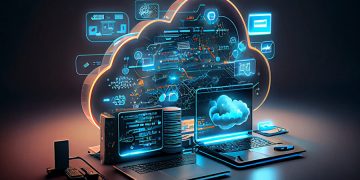In the world of computing, silicon has long been king. For decades, the semiconductor industry has relied on silicon-based chips to power everything from personal devices to supercomputers. Silicon has been the bedrock of technological advancement, driving Moore’s Law and the relentless march of digital progress. However, as we push the boundaries of computational power, we are encountering significant challenges that are forcing us to rethink the very nature of computation. One of the most pressing issues is sustainability: how do we meet the growing demand for computational power without destroying the environment in the process?
In this article, we will explore the search for sustainable and scalable computing solutions, diving into cutting-edge technologies, alternative materials, and innovative architectures that may provide the answer. As we face climate change, energy scarcity, and a host of other global challenges, it is clear that the future of computing cannot be built on silicon alone. Instead, the next generation of computing power will need to be greener, more energy-efficient, and scalable to meet the needs of an increasingly digital world.
The Problem with Silicon
Silicon has served the tech industry well for decades, but it comes with significant limitations. The process of manufacturing silicon chips is energy-intensive and contributes to considerable greenhouse gas emissions. Additionally, as chip transistors shrink to ever smaller sizes in an effort to increase performance, power consumption increases dramatically. This is a phenomenon known as Dennard scaling, where smaller transistors, while faster, require exponentially more energy to operate.
Silicon-based chips also generate a tremendous amount of heat. In data centers, where millions of servers run constantly, cooling systems consume a significant portion of the energy. This has led to the creation of power-hungry “hyperscale” data centers that, while efficient in terms of raw computing power, are far from energy-efficient on a global scale.
With global demand for computing power continuing to skyrocket — particularly for artificial intelligence (AI), machine learning, and big data — these issues have become a serious concern. In fact, some estimates suggest that the energy consumed by data centers could account for as much as 10% of the world’s total energy usage by 2030. This poses a serious risk to our planet’s already strained resources, calling for a rethinking of how we design and build computing systems.
Moving Beyond Silicon: The Search for New Materials
To address the limitations of silicon, researchers and engineers are looking for alternative materials that could offer higher performance, better efficiency, and greater scalability. The search for these new materials is one of the most exciting and challenging areas of modern science, and it could hold the key to solving many of the sustainability issues associated with current computing architectures.
One promising alternative material is graphene, a single layer of carbon atoms arranged in a hexagonal lattice. Graphene has been hailed as a “wonder material” due to its remarkable properties. It is extremely strong, lightweight, and conductive, making it an ideal candidate for next-generation computing. Unlike silicon, graphene can conduct electricity with minimal resistance, which could lead to faster and more energy-efficient chips.
Another material that shows promise is carbon nanotubes. These cylindrical structures, composed of rolled-up graphene sheets, have similar properties to graphene but are even more efficient at conducting electricity. Carbon nanotubes could potentially replace silicon transistors, offering chips that are faster, more efficient, and capable of operating at much lower power levels.
Quantum dots and molecular electronics are also being explored as potential alternatives. Quantum dots are tiny particles that exhibit unique quantum mechanical properties, and they could potentially be used to create new types of transistors that operate at a fraction of the power of silicon-based transistors.
While these materials show great promise, they are still in the early stages of development. Researchers are still working to solve the technical challenges of manufacturing these materials at scale, and it may be several years before they are widely adopted in mainstream computing.

The Role of Edge Computing and Distributed Architectures
In addition to new materials, the future of sustainable and scalable computing will also depend on how we architect and distribute computing power. The rise of edge computing is one of the most important trends in this area.
Edge computing refers to the practice of processing data closer to where it is generated, rather than sending it to distant data centers. By moving computation to the edge — such as in smartphones, sensors, and IoT devices — we can reduce the need for long-distance data transmission, which can be both inefficient and energy-consuming.
Edge computing also reduces the pressure on central data centers, which are often responsible for processing vast amounts of data. By offloading some of this work to devices closer to the source, we can reduce the carbon footprint of data centers and make better use of local resources. This is especially important in the context of AI and machine learning, where large-scale data processing is required.
In the future, distributed architectures will become increasingly important. Instead of relying on a few massive data centers, we may see the rise of decentralized computing networks that leverage local resources to process data. This could be especially important for 5G networks, which promise to deliver ultra-fast connectivity for billions of devices worldwide. Distributed computing could provide the scalability needed to handle the massive amounts of data generated by these devices.
Renewable Energy and Green Data Centers
While new materials and distributed architectures hold promise, energy efficiency will remain the most important factor in building sustainable computing systems. Traditional data centers consume vast amounts of electricity, and much of this energy is still sourced from fossil fuels.
To address this challenge, companies are increasingly turning to renewable energy to power their data centers. Google, Microsoft, and Amazon are leading the charge, committing to using 100% renewable energy in their data centers. By using wind, solar, and hydroelectric power, these companies aim to reduce their carbon footprints and make computing a more sustainable endeavor.
However, renewable energy is not always available on demand, which creates challenges for data centers that need a constant, reliable power supply. To address this, many companies are investing in energy storage systems, such as large-scale batteries, that can store energy when it is abundant and release it when it is needed.
Energy efficiency is also being improved through innovations in cooling systems. Data centers are experimenting with liquid cooling techniques, where coolant is circulated through pipes in direct contact with chips to keep them at optimal temperatures. This reduces the need for traditional air conditioning, which is energy-intensive.
Additionally, some companies are moving their data centers to colder climates to take advantage of natural cooling. In the Nordic countries, for example, companies like Facebook and Microsoft are building massive data centers that use the cold air to keep the equipment cool, significantly reducing the energy required for air conditioning.
The Road Ahead: Collaborative Innovation
The search for sustainable and scalable computing solutions is not something that can be achieved by any one company or country alone. It will require a global effort and collaboration across industries, governments, and academia.
We are at a crossroads in the history of computing, where innovation in materials, architecture, and energy efficiency must go hand-in-hand. New technologies, such as quantum computing and neuromorphic systems, hold the potential to revolutionize the way we think about and use computing power. Meanwhile, distributed systems and edge computing promise to make computing more efficient and accessible, especially in developing regions.
But to truly realize the potential of these technologies, we must ensure that sustainability is at the forefront of our efforts. The next generation of computing will not only need to deliver higher performance and greater scalability, but it must also do so in a way that respects the planet and its resources.
As we continue to push the boundaries of what is possible with computing power, we must remember that the future is not just about more compute. It is about better compute — smarter, greener, and more efficient. The search for sustainable and scalable computing is not just a technological challenge; it is a moral imperative. In the end, the solutions we develop will determine not only the future of computing but the future of our planet.












































